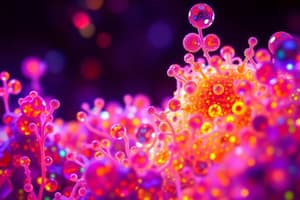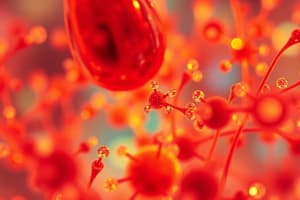Podcast
Questions and Answers
What type of microscope is the bright-field microscope?
What type of microscope is the bright-field microscope?
- A scanning electron microscope
- A fluorescence microscope
- A transmission electron microscope
- A light microscope and a compound microscope (correct)
What is the typical magnification range of the objective lenses in a bright-field microscope?
What is the typical magnification range of the objective lenses in a bright-field microscope?
- 4x to 100x (correct)
- 2x to 50x
- 20x to 1000x
- 10x to 500x
How is the total magnification of a bright-field microscope calculated?
How is the total magnification of a bright-field microscope calculated?
- By adding the ocular magnification and the objective magnification
- By multiplying the ocular magnification by the objective magnification (correct)
- By dividing the ocular magnification by the objective magnification
- By subtracting the objective magnification from the ocular magnification
What is the typical magnification of the ocular lenses in a bright-field microscope?
What is the typical magnification of the ocular lenses in a bright-field microscope?
What is the purpose of the x-y mechanical stage knobs on a bright-field microscope?
What is the purpose of the x-y mechanical stage knobs on a bright-field microscope?
What is the term used to refer to the sample being viewed under a bright-field microscope?
What is the term used to refer to the sample being viewed under a bright-field microscope?
What knob is used for large-scale movements with the 4x and 10x objective lenses?
What knob is used for large-scale movements with the 4x and 10x objective lenses?
Why do highly magnified images produced by microscopes require intense lighting?
Why do highly magnified images produced by microscopes require intense lighting?
What provides the light in a bright-field microscope?
What provides the light in a bright-field microscope?
What is adjusted by opening or closing a diaphragm between the condenser and the specimen?
What is adjusted by opening or closing a diaphragm between the condenser and the specimen?
Which knob is used for small-scale movements, especially with 40x or 100x objective lenses?
Which knob is used for small-scale movements, especially with 40x or 100x objective lenses?
What controls the intensity of the illuminator in a microscope?
What controls the intensity of the illuminator in a microscope?
What is the primary purpose of the coarse focusing knob on a bright-field microscope?
What is the primary purpose of the coarse focusing knob on a bright-field microscope?
What is the purpose of the diaphragm located between the condenser and the specimen in a bright-field microscope?
What is the purpose of the diaphragm located between the condenser and the specimen in a bright-field microscope?
How does the brightness of the image change as the magnification increases in a bright-field microscope?
How does the brightness of the image change as the magnification increases in a bright-field microscope?
What is the purpose of the $x$-$y$ mechanical stage knobs on a bright-field microscope?
What is the purpose of the $x$-$y$ mechanical stage knobs on a bright-field microscope?
What component provides the light source in a bright-field microscope?
What component provides the light source in a bright-field microscope?
What is the purpose of the fine focusing knob on a bright-field microscope?
What is the purpose of the fine focusing knob on a bright-field microscope?
What component is used to focus the light rays on the specimen in a bright-field microscope?
What component is used to focus the light rays on the specimen in a bright-field microscope?
What component is used to control the intensity of the illuminator in a bright-field microscope?
What component is used to control the intensity of the illuminator in a bright-field microscope?
What type of microscope is the bright-field microscope?
What type of microscope is the bright-field microscope?
What is the purpose of the ocular lenses in a bright-field microscope?
What is the purpose of the ocular lenses in a bright-field microscope?
How is the total magnification of a bright-field microscope calculated?
How is the total magnification of a bright-field microscope calculated?
What is the typical magnification range of the objective lenses in a bright-field microscope?
What is the typical magnification range of the objective lenses in a bright-field microscope?
What is the term used to refer to the sample being viewed under a bright-field microscope?
What is the term used to refer to the sample being viewed under a bright-field microscope?
What is the purpose of the x-y mechanical stage knobs on a bright-field microscope?
What is the purpose of the x-y mechanical stage knobs on a bright-field microscope?
What provides the light in a bright-field microscope?
What provides the light in a bright-field microscope?
What is the purpose of the diaphragm in a bright-field microscope?
What is the purpose of the diaphragm in a bright-field microscope?
What factor affects the resolution of objects under a microscope by enabling us to distinguish two separate points or objects?
What factor affects the resolution of objects under a microscope by enabling us to distinguish two separate points or objects?
Why does an electron microscope generally have a higher resolution than a light microscope?
Why does an electron microscope generally have a higher resolution than a light microscope?
Which factor contributes significantly to better resolution in a microscope by measuring a lens's ability to gather light?
Which factor contributes significantly to better resolution in a microscope by measuring a lens's ability to gather light?
What can be used to overcome compromised resolution at high magnifications in a light microscope due to the air between the specimen and lens?
What can be used to overcome compromised resolution at high magnifications in a light microscope due to the air between the specimen and lens?
What happens to resolution in a light microscope at very high magnifications when light passes through the small amount of air between the specimen and the lens?
What happens to resolution in a light microscope at very high magnifications when light passes through the small amount of air between the specimen and the lens?
Why does an electron microscope offer much higher resolution than a light microscope?
Why does an electron microscope offer much higher resolution than a light microscope?
Which characteristic of a lens can greatly impact the resolution of a microscope by affecting how well light is captured?
Which characteristic of a lens can greatly impact the resolution of a microscope by affecting how well light is captured?
What effect does the use of immersion oil have on the resolution of the microscope image?
What effect does the use of immersion oil have on the resolution of the microscope image?
What is the primary function of the immersion oil in a microscope setup?
What is the primary function of the immersion oil in a microscope setup?
What is the primary advantage of using immersion oil with a 100x objective lens?
What is the primary advantage of using immersion oil with a 100x objective lens?
What is the primary purpose of the condenser in a bright-field microscope?
What is the primary purpose of the condenser in a bright-field microscope?
What is the primary function of the diaphragm in a bright-field microscope?
What is the primary function of the diaphragm in a bright-field microscope?
Which of the following is a common cellular morphology observed in bacteria?
Which of the following is a common cellular morphology observed in bacteria?
What is the term used to describe the pattern formed by bacterial cells during cellular division?
What is the term used to describe the pattern formed by bacterial cells during cellular division?
How does the use of immersion oil affect the numerical aperture of the objective lens in a bright-field microscope?
How does the use of immersion oil affect the numerical aperture of the objective lens in a bright-field microscope?
Flashcards are hidden until you start studying
Study Notes
Bright-Field Microscope
- A bright-field microscope is a type of compound microscope that produces a dark image on a bright background.
- It is the most commonly used type of microscope.
Components of a Bright-Field Microscope
- The microscope has two or more lenses that work together to create a magnified image.
- The ocular lens typically magnifies images 10 times (10x).
- The objective lenses, located on a rotating nosepiece, have a magnification range of 4x to 100x.
- The total magnification is calculated by multiplying the ocular magnification with the objective magnification.
Preparing a Specimen
- A specimen is placed on a glass slide, which is then clipped into place on the stage of the microscope.
- The slide is positioned over the light using the x-y mechanical stage knobs.
- The coarse focusing knob is used for large-scale movements with 4x and 10x objective lenses.
- The fine focusing knob is used for small-scale movements, especially with 40x or 100x objective lenses.
Lighting in a Bright-Field Microscope
- Intense lighting is required for highly magnified images.
- The illuminator, typically a high-intensity bulb below the stage, provides the light.
- Light passes through a condenser lens, which focuses the light rays on the specimen to maximize illumination.
- The amount of light striking the specimen can be adjusted using a diaphragm or a rheostat (dimmer switch).
Magnification and Resolution
- Greater magnification improves our ability to see details of small objects, but magnification alone is not sufficient to make the most useful images.
- Resolution, the ability to tell that two separate points or objects are separate, is affected by wavelength and numerical aperture.
- Electron microscopes have a much higher resolution than light microscopes due to their shorter wavelengths.
Immersion Oil
- At very high magnifications, resolution may be compromised due to the large refraction difference between air and glass.
- Using a drop of immersion oil between the specimen and an oil immersion lens can solve this problem.
- Immersion oil has a refractive index similar to that of glass, increasing the maximum angle at which light leaving the specimen can strike the lens, thus increasing the resolution of the image.
Observing Microbes
- When observing microbes, specifically bacteria, under the microscope, you can see a variety of cellular morphologies and arrangements.
- There are six main types of cellular morphologies for bacteria.
- Bacteria can be grouped into cellular arrangements, which refer to the pattern that forms during cellular division.
Studying That Suits You
Use AI to generate personalized quizzes and flashcards to suit your learning preferences.




